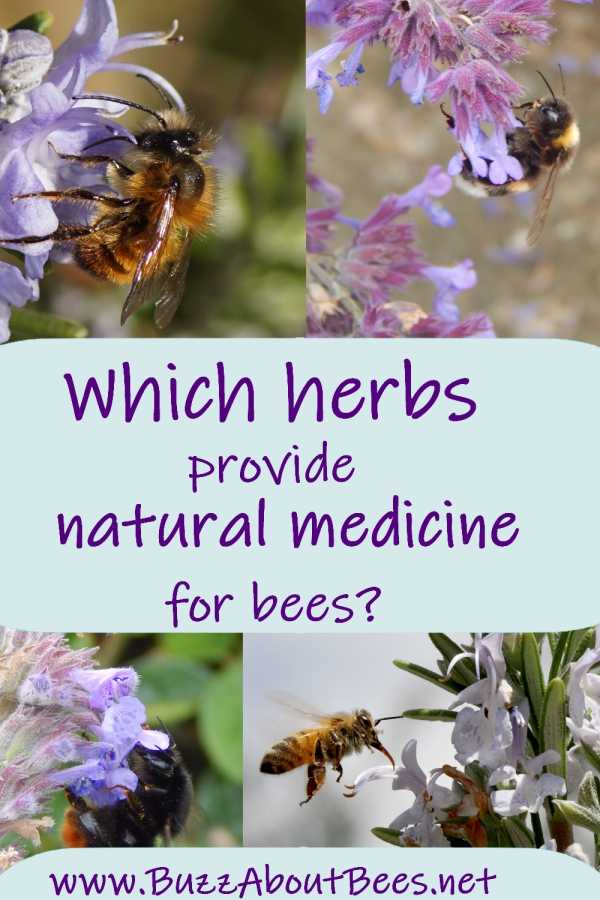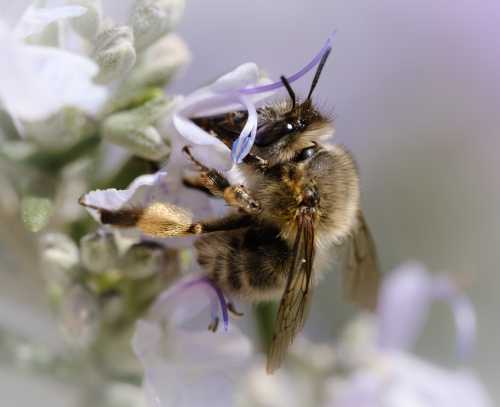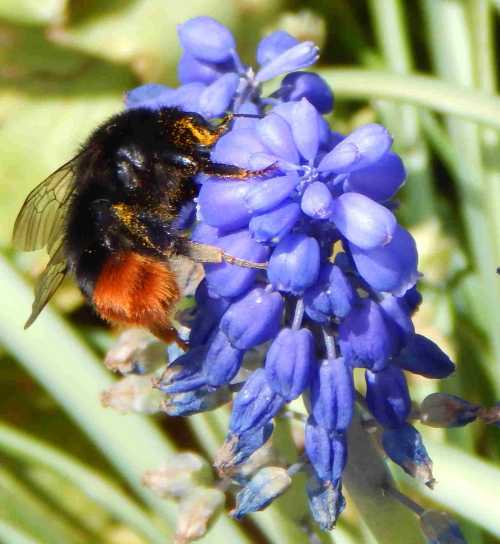Herb Planting For Bees
There's a great variety of wild and cultivated herbs for bees out there, and many herbs are among the best plants for bees and other pollinators, such as butterflies and hoverflies.
Whilst it's known that many herbs are popular with bees, what is perhaps less well-known is that at lease some of them have been show to provide bees with medicinal benefits too! Read on to find out which!
A List Of Herbs For Bees And Pollinators
Here are my favourite herbs for bees:
1. Anise hyssop - Agastache foeniculum
A wonderful, aromatic bee plant and herb, and the leaves are sometimes used to make a tea, or eaten in salads. This is a herbaceous perennial and comes from the mint family.
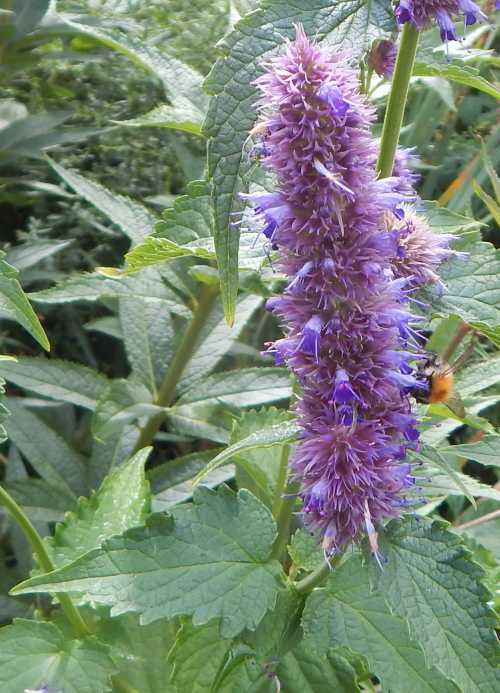 Bumble bee on Anise hyssop, Agastache foeniculum
Bumble bee on Anise hyssop, Agastache foeniculumProvide well drained soil and ensure it has full sun.
You can start this plant with seeds, and divide the clumps in spring when established to plant elsewhere around the garden, or share with friends.
2. Oregano / Marjoram - Origanum
Fragrant, culinary oregano and marjoram are loved by all kinds of bees (bumble bees, honey bees and a range of solitary bees,) as well as other pollinators.
In one study, as many as 21 different bee species were observed to visit Origano shrubs within a given a period, and that the plant is long-flowering - read the detail in my page about planting Oregano for bees.
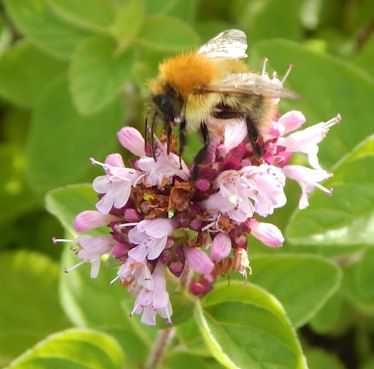 Bees love Oregano!
Bees love Oregano!Oregano has pretty pink flowers, available in a range of shades.
Dwarf varieties are available, and you can freeze or dry the leaves to enjoy them in your cooking later.
3. Rosemary - Salvia rosmarinus / Rosmarinus officinalis
Rosemary is a lovely aromatic herb that will provide nectar and pollen for bees from early spring onwards.
There may be other benefits to bees too! Read about planting Rosemary for bees.
4. Thyme - Thymus
Thyme is great for small garden spaces. It can be grown in pots, the rockery or border, as long as it's in a well-drained, sunny spot.
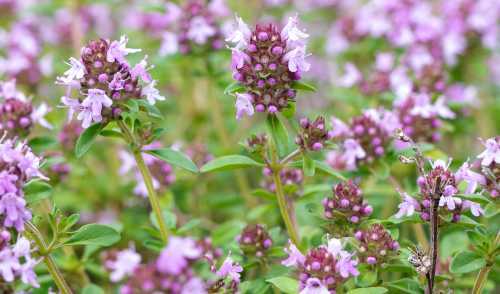 Thyme
ThymeIt can even be used to create a small patch of decorative lawn.
Research suggests that not only does Thyme provide nectar and pollen for bees, but also may help maintain bee health by providing natural protection against bacteria and diseases. Other pollinators such as butterflies like thymes too.
You can read more about this on my page: Do bees like thyme?
5. Chives - Allium schoenoprasum
For chives to be beneficial to bees, you obviously have to allow them to flower. You can still clip some of the stalks for cooking.
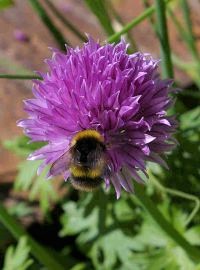 Chives in flower.
The flowers are attractive
and bees love them.
Chives in flower.
The flowers are attractive
and bees love them.Again, I have found chives easy to grow from seed. I start them off in small pots, then plant them out in the garden.
They begin quite spindly with just a few
stems, but soon fill out the following year.
6. Lavender - Lavendula
Choose different lavender varieties for a prolonged season.
 Bumble bee on English lavender - popular and fragrant herb
Bumble bee on English lavender - popular and fragrant herbYou can propagate more plants from cuttings, but ensure you take quite a few as they may not all 'take'.
7. Borage - Borago officinalis
I have read that Borage refills with nectar every 2 minutes! Certainly, there is plenty of scientific evidence confirming that Borage flowers provide lots of nectar and pollen for bees and pollinators1.
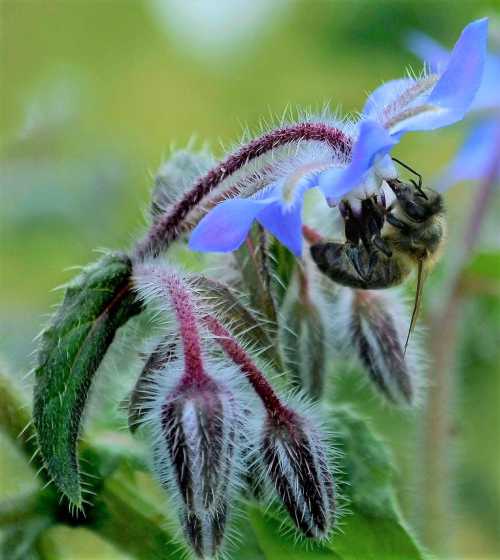 Borage is popular with bees.
Borage is popular with bees.It's not uncommon for beekeepers to seek out borage fields with the aim of producing borage honey.
Borage is a favourite with bees, and is easy to grow from seed. In my experience, it grows quite tall, and can look a little 'gangly', so I think it's best if it occupies a space at the back of the flower border.
8. Mints & Sages - Mentha & Salvias
Some well-known favourites for bees and pollinators, fall within the mints and sages categories.
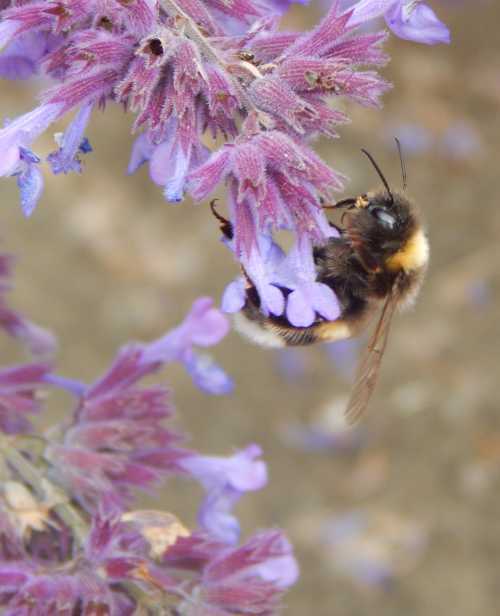 Bumble bee on Catmint (Nepeta).
Bumble bee on Catmint (Nepeta).Read more about this group on my page Do bees like mints?
9. Comfrey - Symphytum officinale
Another excellent flower for bees – refills with nectar approximately every 45 minutes.
All kinds of bumble bees and solitary bees feed on it, as well as honey bees.
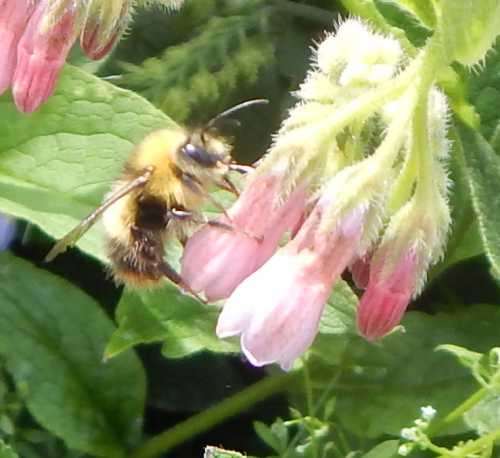 Bees may be spotted nectar robbing comfrey.
Bees may be spotted nectar robbing comfrey.Some shorter tongued bees may engage in nectar robbing to access the nectaries, as pictured above.
However, be careful when planting in the garden - it's vigorous growth habit can be unpopular. Check that it's not invasive in your country before planting!
10. Dill - Anethum graveolens
Dill is one of the herbs I use most often in cooking. It has a gorgeous, delicate flavour I find very versatile in the kitchen.
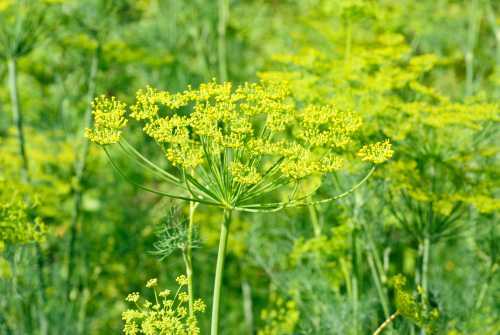 Dill
DillWhen allowed to flower, it is also especially enjoyed by honey bees and butterflies (such as swallowtails if you have them in your country).
Dill adds a graceful softness to a border if you have the space for it.
11. Lemon Balm - Melissa officinalis
In the
past, beekeepers would rub a handful of lemon balm (Melissa officinalis)
inside the hive after hiving a new swarm, in order to help the swarm
settle and to encourage them not to leave the hive.
Rubbing hands with the leaves is also claimed to help prevent bee stings!
12. Fennel - Foeniculum vulgare
Also popular with seed-eating birds and hoverflies, as well as bees.
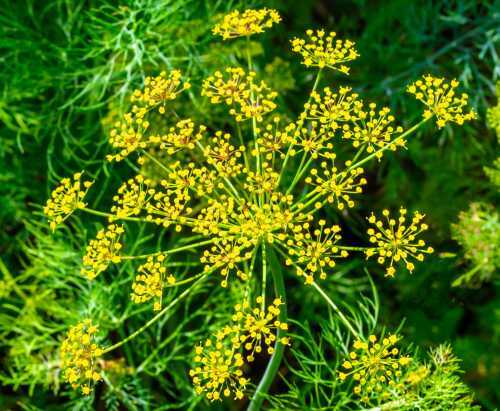 Fennel
FennelFind out how to grow Fennel.
13. Bee Balm / Wild Bergamot - Monarda fistulosa
Often referred to as 'bee balm'. Long tongued bees especially, enjoy this pretty herb.
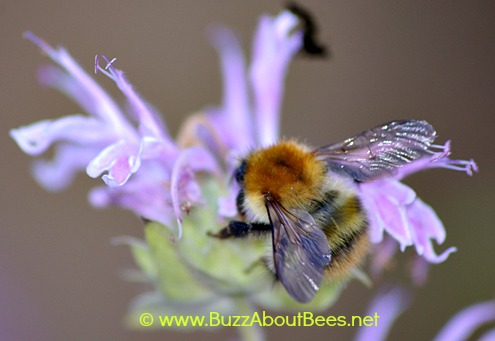 Common carder bee on Wild Bergamot
Common carder bee on Wild BergamotCultivated varieties of Monarda are available.
References
1. Stawiarz, Ernest, Wróblewska, Anna, Masierowska, Marzena and Sadowska, Dagmara. "Flowering, Forage Value, and Insect Pollination in Borage (Borago Officinalis L.) Cultivated in Se Poland" Journal of Apicultural Science, vol.64, no.1, 2020, pp.77-89. https://doi.org/10.2478/jas-2020-0005.
More articles about bees and plants
- Bees And Brambles: The Value Of Brambles To Bees Also known as blackberry bush, research shows each bramble flower secretes lots of nectar for bees!
- Bees And Bee Balm Bee Balm (Monarda) - also known as 'Bergamot) is a herbaceous perennial which is attractive for bees.
- 30 Fantastic Garden Flowers For Bees Flowering plant recommendations for the perfect bee garden.
- Bees love lupins – but so do slugs and snails, so what can you do? Here's a way to protect your lupins....using garlic!
- Plant Oregano For Bees (Marjoram) It's rich in nectar, and attracts bees, butterflies and hoverflies in summer. Here's how to plant it.
- Fennel Pollen And Nectar Bees love fennel! How to grow it, gather it, and the many uses of fennel seeds and pollen.
If you found this page helpful or interesting, I'd really be grateful if you would share it with others - if not this page, perhaps another, such as Gardening For Bees.
Thank you so much :) .
